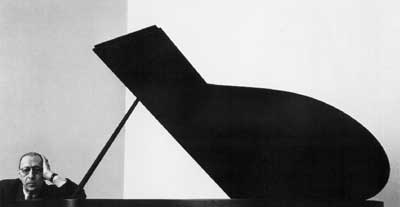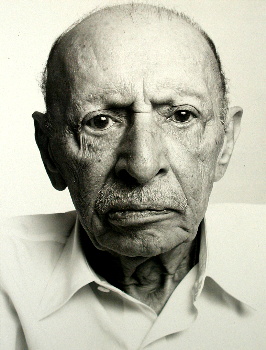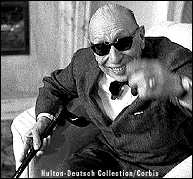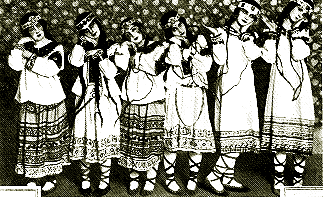
Igor Stravinsky: The Rite of Spring (1911-1913)
Score
Columbia's Online Reserves Recording 1. or Recording 2.

Igor Stravinsky: The Rite of Spring (1911-1913)
Score
Columbia's Online Reserves Recording 1. or Recording 2.
|
Igor Stravinsky's ballet Le Sacre du Printemps known in English as The Rite of Spring was a sensation from the moment it first appeared on stage. The unrelentingly percussive and dissonant music of Stravinsky combined with Vaslav Nijinsky's rule-breaking choreography, Nicholas Roerich's remarkably evocative sets and costumes and the atmosphere of Paris in the years leading to the First World War led to a riot of proportions unheard of in music before or since. The noise in the theater was said to be so loud that the dancers were unable to hear the music played by the enormous orchestra and instead were forced to rely on Nijinsky's shouting the count from the wings of the theater; Stravinsky had to be escorted from the hall wiith a police escort. What was it about this music that caused such an uproar? While it was likely the result of a claque of Stravinsky's enemies (the second performance went off without a hitch), it could equally be a result at the sheer visceral nature of the score: its vulgar primitivism, its unrelenting rhythmic hammering and the freeflowing sexuality of the music and dance. The Rite of Spring was an exploration of nature, subtitled "Scenes from Pagan Russia" that did not hide behind Victorian niceities: physical nature and human nature were laid bare. Musical conventions were turned on their head, from the superposition of two chords not often played simultaneously in the tableaux known as Augurs of Spring to the unpredictable accents of this repeated chord. (track 2 beginning). Stravinsky's intention was to celebrate a ritual, the annual renewal of spring through the sacrifice of a virgin who was meant to dance herself to death. He sought not to illustrate the pleasant arrival of spring: the trite images of the lovely Month of May and buds opening but rather a more elemental spring: that of glaciers calving and buds struggling forth from the hardened soil. Stravinsky's music is filled with snippets of Russian folksong filtered through his own brilliant ears. Some is from previously published collections, others were collected by Stravinsky or remembered from his childhood and still others were entirely invented. The ballet uses these source melodies as raw material, tearing off tiny figures, perhaps even three notes, to use as ostinatos (repeating series of chords or notes) and patterns or as an environment for rhythm. Such treatment is even a folk derived notion. For instance let's say we had a passage of music: ABCDEFG. Stravinsky might fixate upon four notes: BCDE and repeat these endlessly with variations: BCDE BCD CD CD BCD CCC DBC DB DB and so forth. This idea of a flexible musical object lies at the heart of Stravinsky's technique. For a new listener a good way to think about Stravinsky's technique on both the larger scale and the smaller scale is like the technique of montage in film. For instance, if I were going to shoot a scene describing a briilliant car chase. I may have four different angles that I would move between: the car speeding down the road (A); the scared passenger (B); the pursuit vehicle (C); and astonished bystanders (D). In a film to heighten the emotion and revel in the excitement of the chase, I would cut between these various views. One editing could be: ACBD CB AD and so forth. So too is montage used in Stravinsky's music but instead of scenes of film we are working with sharply defined sound elements. |
 |

|
Synopsis of the Ballet:
Part I: The Adoration of the Earth We hear what are ostensibly Shepherds' pipes and the curtain rises to reveal a village celebration in an ancient Slavonic village. Village scenes play out: among them a witch seeing the future, an abduction leading to marriage, dances and games. The oldest and wisest members of the village arrive in great procession. They begin the solemn ritual of the "Adoration of the Earth" during which the Sage kisses the newly flowering earth. Part II: The Sacrifice We again hear a mysterious introduction and see a dance of virgins. One is chosen to be sacrificed to the Earth and glorified by the village. In the presence of village elders and dressed in bearskin she dances herself to death in order to bring forth the flowering of spring. |
 |
|
First Part: The Adoration of the Earth Track 1: Introduction (2:57) Track 2: Les Augures Printanieres (3:03) Track 3: Jeu de Rapt (1:17) Track 4: Rondes Printanieres (3:05) Track 5: Jeux des Cites Rivales (1:59) Track 6: Cortege du Sage(0:43) Track 7: Adoration de la Terre (Le Sage) (0:25) Track 8: Danse de la Terre (1:14) Second Part: The Sacrifice Track 9: Introduction (3:41) Track 10: Cercles Mysterieux des Adolescents (2:51) Track 11: Glorification de l'Elue (1:35) Track 12: Evocation des Ancetres (0:42) Track 13: Action Rituelle des Ancetres (3:19) Track 14: Dance Sacrake (L'Elue) (4:37) |
First Part: The Adoration of the Earth Introduction The Augurs of Spring; Dances of the Young Girls Ritual of Abduction Spring Rounds Ritual of the Rival Tribes Procession of the Sage The Sage Dance of the Earth Second Part: The Sacrifice Introduction Mystic Circles of the Young Girls Glorification of the Chosen One Evocation of the Ancestors Ritual Action of the Ancestors Sacrificial Dance (The Chosen One) |
|
Listening Chart: Based on Stravinsky recording Part One: Introduction
Part One: Augurs of Spring
Part One: Ritual of Abduction
Part One: Spring Rounds
|
The Joffrey Ballet's reconstruction of the original performance |